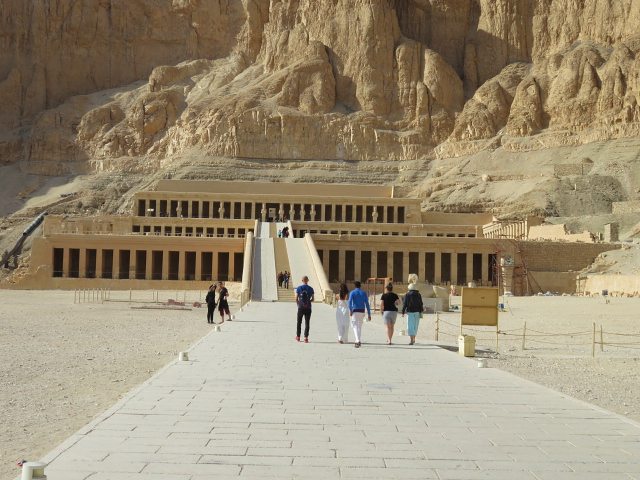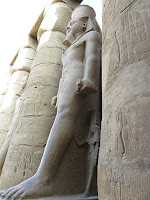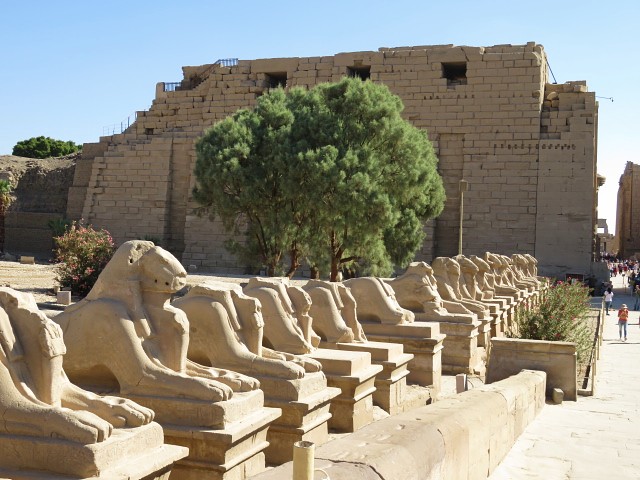3 days in Luxor
Should you take a guided tour?
Luxor is a place you can easily explore on your own. It is compact enough to be walkable, but if you feel more comfortable taking a guided tour then head over to Viator or GetYourGuide for a great range of tours. Most of the tours have 'free cancellations' up to 24 hours in advance.
Powered by GetYourGuide
Day 1: Karnak and the Temple of Luxor
You will need a full day to explore the temples of Karnak and Luxor. Luxor Temple is right in the centre of town opposite the Nile River so if you have any spare time it is a great place to walk from and perhaps take in the Luxor Museum or the Mummification Museum. If you are looking for lunch between temples the Winter Palace not far south of Luxor Temple along the river has a lovely garden cafe.
The Temple of Karnak
Karnak is a massive site covering more than 2 sq km (1 sq mi) comprising temples, obelisks, columns, statutes and even an artificial lake. Leave yourself plenty of time - 3 hours or more. As well as ticking off the highlights try wandering, getting lost and discovering some of Karnak's quiet corners away from the tour bus crowds. The bus car park at Karnak was one of the few places in Egypt where we could see evidence of tourism returning to the country. Fortunately Karnak is so large it swallowed the crowds easily.
Highlights of Karnak
- The Great Hypostyle Hall. Consisting of 134 papyrus shaped pillars you can't miss the Great Hypostyle Hall. Walk straight ahead as you enter the temple complex and you will find yourself in this ancient, towering stone forest spread over 5,500 sq m (59,000 sq ft).
 |
| Great Hypostyle Hall at the Temple of Karnak |
- The Obelisk of Hatshepsut. At 30 m high (98 ft) the Obelisk of Hatshepsut is the tallest in Egypt. Keep walking straight ahead through the Great Hypostyle Hall and you can't miss it.
 |
| Obelisk of Hatshepsut at the Temple of Karnak |
- Avenue of the Sphinxes. The Avenue of the Sphinxes are two lines of sphinxes guarding both sides of a 3 km path between Karnak and Luxor Temple. The avenue is in the process of being restored. In December 2018 while we were in Luxor the path was blocked off to visitors but you can see the sphinxes from either end at both Karnak and Luxor Temple.
 |
| Sphinxes at Karnak |
- The Giant Scarab. Only the Ancient Egyptians would make a beetle, and a dung beetle at that, a sacred symbol. We found scarabs everywhere in Egypt, most often in the hands of souvenir sellers who were trying to entice us with a 'free' gift. The giant scarab at Karnak is however in a class of its own. Carved in stone and sitting atop a pedestal it was dedicated by Amenhotep III to Khepri (one of the names for the sun god).
There are stories which say if you walk around it five times (or seven times or something, depending on who is telling the story) you will fall pregnant - not sure how that works for men but I can tell you it didn't work for me! When I walked around it in 2006 I had two children. In 2018 I still have two children - now adults. This time I didn't bother doing the walking around thing. Perhaps you have to actually want to get pregnant!
Look for the Giant Scarab near the Sacred Lake.
 |
| David and I standing in front of a giant, stone dung beetle - you almost have to wonder why we posed for this! |
- The Sacred Lake. Like a backyard swimming pool after a summer of neglect, the Sacred Lake is in need of a good dose of chlorine. It was said by Herodotus that the priests of Amun (one of the most important gods of Ancient Egypt) bathed daily and nightly for ritual purity. If the lake was the same grey-green featureless pond then that it is today then it is one more reason to distrust Herodotus*.
Go out the back of the temple and turn right to find the Great Lake.
*Herodotus was an early Greek historian known to never let the facts get in the way of a good story - a man after my own heart!
 |
| Sacred Lake Karnak - you can see what I mean about the need for chlorine. |
- The Fallen Obelisk of Hatshepsut. The Fallen Obelisk of Hatshepsut is behind the Giant Scarab near the Sacred Lake - my directions are beginning to sound a bit like a computer game. Only the tip remains but it is worth a quick look. For a much more impressive recumbent obelisk you need to travel to Aswan and visit the Unfinished Obelisk there.
How much do tickets to Karnak cost?
Adult entrance tickets to the Karnak cost 150 EGP (12 AUD/9 USD).
Luxor Temple
Three kilometres (1.8 mi) from Karnak is the Temple of Luxor. Across the road from the Nile River and almost in the centre of town it would be incongruous anywhere else - but in Egypt it feels like the beating heart of the once great city.
More compact and much easier to find your way around than Karnak, Luxor is my favourite of the two. If you only have time for one temple, skip Karnak and immerse yourself in the ancient rhythm of Luxor instead.
Begun more than thirteen hundred years before the birth of Christ, Luxor was built by the pharaoh Amenhotep III and added to by Ramses II, Tutankhamun and Alexander the Great. The temple came to life every year in the second month of the lunar calendar when statutes of the gods Amun, Mut and Khonsu were brought from Karnak along the Avenue of the Sphinxes.
How to get to the ticket office for Luxor Temple
Finding the Luxor Temple ticket office is far trickier than it sounds. The entrance is hidden away down an innocuous looking set of steps. Walk around to the back of the temple (the side furthest from the River Nile), cross the carpark and look for a set of steps not far to the left of the entrance to the Abou al-Haggag Mosque. The ticket office is on the left at the bottom of the stairs.
How much do tickets to the Temple of Luxor cost?
Entrance tickets are 140 EGP (11 AUD /8 USD) for adults, and 70 EGP (6 AUD/4 USD) for students. There is no need for a photography ticket unless you want to use a tripod which costs 20 EGP ( 1.6 AUD/1 USD).
Don't miss the Avenue of the Sphinxes
When their restoration is complete you will be able to walk the entire Avenue of the Sphinxes between Karnak and Luxor temples. For now you will have to be content, as we were, to see the sphinxes from behind construction barriers. The avenue begins at the Luxor Temple end directly opposite the entrance to the temple. You can see the sphinxes from the surrounding streets and get up quite close once you have purchased your Luxor Temple ticket.
 |
| Andrew and David - being guys! At Luxor Temple. |
 |
| An obelisk at Luxor Temple. |
 |
| Avenue of the Sphinxes at Luxor Temple |
 |
| Luxor Temple |
Day 2 & 3: The west bank of the Nile
The West Bank of the Nile has so many sights you really need a few days there. You can do it in a day if you start early, rush through everything and don't mind missing a lot. Two days is better. If you are slow to get started in the mornings and like to have plenty of time to explore then three days is perfect.
Head to the Valley of the Kings on your first day, stopping at the Colossi of Memnon on the way, then see Howard Carter House and the Tombs of the Nobles (if you have time). On day 3 mop up with the Valley of the Queens, the Memorial Temple of Hatshepsut, Medinat Habu, and the Ramesseum. If you have time Deir Al Medina is worth seeing. This is where the workmen who crafted the tombs in the Valley of the Kings and Queens lived and built their own tombs.
The Valley of the Kings
This is the West Bank site you really don't want to miss. A massive ancient necropolis dotted with the tombs of pharaohs. I have dedicated a whole post to it. Click the link for How to visit the Valley of the Kings: What you need to know in 2019!
 |
| Inside the Tomb of Rameses V & VI at the Valley of the Kings |
Howard Carter House
If you have even a passing interest in the man who discovered the Tomb of Tutankhamun then Howard Carter House is worth stopping at on your way to or from the Valley of the Kings. You will go straight past it. There is a replica of Tutankhamun's burial chamber in the garden which is the closest you will get to being allowed to take a photo inside Tutankhamun's Tomb.
For everything you need to know about visiting Howard Carter House click on my previous post - Howard Carter House and the Tomb of Tutankhamun
 |
| Howard Carter House |
The Valley of the Queens and the Tombs of the Nobles
If you only have time for one of these I suggest the Tombs of the Nobles. While the Valley of the Queens is fabulous it is much the same as the Valley of the Kings. The Tombs of the Nobles are smaller and more intimate and the commercial touristy feeling of the Valleys of the Kings and Queens doesn't permeate this far down the ancient burial site pecking order.
Note: You must buy your tickets for the tombs at the Valley of the Nobles ticket office just past the Colossi of Memnon. This is the same ticket office where you get tickets to Howard Carter House. You need to know which tombs you want to visit so do a bit of research beforehand. The tickets come in groups of two or three tombs. Lonely Planet has descriptions of each of the tombs.
 |
| The Valley of the Nobles |
Memorial Temple of Hatshepsut
Even if you are totally templed out by the time you visit the west bank, the Memorial Temple of Hatshepsut is worth a visit. Architecturally different from all the other temples we visited, Hatshepsut is all about the grand entrance (at the front) and dramatic limestone cliffs (at the back).
Hatshepsut married her half-brother, Thutmose II when she was 12 becoming Queen of Egypt in the process. When Thutmose II died she acted as regent for her infant stepson Tuthmose III with whom she later became co-ruler - technically at least. It seems that Hatshepsut had all the power. In any event it can't have been a happy partnership because after she died Thutmose III defaced her statutes and monuments removing much of the evidence of his stepmother's reign.
Tickets: An adult entrance ticket to the Temple of Hatshepsut costs 100 EGP (8 AUD/6 USD).
Tickets: An adult entrance ticket to the Temple of Hatshepsut costs 100 EGP (8 AUD/6 USD).
 |
| Temple of Hatshepsut |
Medinat Habu Temple
Medinat Habu is a memorial temple built by Ramses III (1186 -1155 BC). If you have the time it is well worth exploring. Lonely Planet describes it as one of the west bank's most underrated sites. I am inclined to agree. It is one of the largest memorial temples in Egypt with well preserved buildings and towering reliefs.
Tickets: An adult entrance ticket costs 80 EGP (5 AUD/7 USD).
Note: Buy your tickets at the Valley of the Nobles ticket office just past the Colossi of Memnon. Make sure you ask for the 'Habu Temple III' ticket. We mistakenly bought tickets to Deir Al Medina (the Workers' Tombs). There is a sign saying that changes in tickets are not allowed 'under any circumstances' however when the ticket seller realised we wanted to swap our tickets for cheaper tickets and we weren't asking for the extra money to be refunded he changed them over - and no doubt pocketed the difference, but we weren't about to complain.
 |
| Medinat Habu |
 |
| Wall relief at Medinat Habu |
Ramesseum
The Ramesseum, a memorial temple built by Ramses II is in less well-preserved condition than the other temples we visited. If you are pushed for time this is the temple to miss. I confess that we drove straight past without going in. You get quite a good view of it from the road!
Colossi of Memnon
The Colossi of Memnon are huge. They are estimated to weight 720 tons each. Twin statutes of Amenhotep III they have not exactly stood the test of time. Though they are upright they are weathered and cracked. Right by the side of the road it only takes a couple of minutes to stop and snap a picture before heading to any of the other west bank sites. Don't bother listening for the singing sound the northern statute was once reputed to make - it hasn't been heard for many centuries. There is no entry charge.
 |
| Colossi of Memnon |
Save this for later. Pin it to Pinterest




One day - thx for the motivation to make a trip to Egypt happen sooner than later!
ReplyDeleteSooner is good with Egypt - before the crowds return.
DeleteI loved Egypt and really enjoyed your article. I did everything you wrote about and loved every moment. Did you go to Luxor Temple at night? It's so beautiful and mysterious.
ReplyDeleteNo. We didn't. I am sure it was stunning. David and I rarely go out at night when we travel - boring I know but I am definitely not an evening person. I don't like going out at night much at home either. We do stay in lots of hotel rooms with stunning views though so we don't miss out entirely. In Luxor we stayed at the Hilton and had a beautiful view of the west bank.
DeleteI've been enjoying all your posts from Egypt and your cruise down the Nile. Luxor looks remarkable with all the architecture. I agree with your thought that the ancient Egyptians loved to build. I wonder if three days is enough?
ReplyDeleteHonestly, I could have spent a week there. Most people arrive before or after a Nile Cruise so 3 days is about all they give it.
DeleteOh the memories! I visited Luxor, Karnak, Valley of Kings and Queens 20+ years ago. It was an amazing, memorable trip and you gave me a great trip down memory lane. The thing is, my photos are terrible. I didn't even have a digital camera back then. I think I need to go back!!!
ReplyDeleteI would definitely recommend a return visit. This was a return visit for us and I think enjoyed it even more the second time around. I did however manage to do the whole trip with my camera on the wrong setting (email size) which affected the quality of the images. They have come out okay in my blog but they're pretty ordinary when I play them back on my digital photo frame - oh well!
DeleteThis looks amazing. I have Egypt slatted for the fall of 2021 and I had 3 days allotted for this items. Based on what you have here, it looks like it it enough time. So happy! I can't wait to look through the rest of your blogs on Egypt! Pinning this one for sure!
ReplyDeleteI hope you enjoy Egypt as much as we did.
Delete